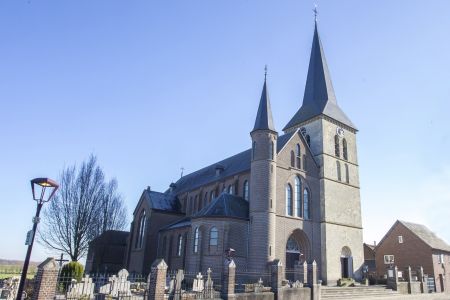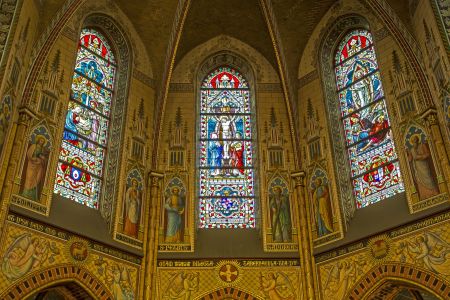Church | 1898 | Neogothic | Catholic Church



Map
Opening hours
01 January - 31 December
Mon 10.00 - 17.00
Tue 10.00 - 17.00
Wed 10.00 - 17.00
Thu 10.00 - 17.00
Fri 10.00 - 17.00
Sat 10.00 - 17.00
Sun 10.00 - 17.00
Limited access due to a glass ag partition.
Religious offices
Description
The architect Jos Tonnaer from the village of Thorn designed both the structural work as the interior of the church. The consistent application of this principle led to this church forming a very neat and harmonious whole carried out by capable and renowned artists and artisans. The decoration doesn’t just serve as a mere embellishment of the building, but wants to consciously contribute to the expansion of knowledge and the experience of a greater faith for the churchgoers.
KIKIRPA : Photo-library online
Photos
Remarkable elements
Neo-gothic interior
The St. Martin’s church of Kessenich was designed in 1898 by the architect Jos Tonnaer from the village of Thorn. He was a student and colleague of the well-known Dutch master builder Pierre Cuypers.
To neo-gothic views, the architect would be responsible for not only the structural work, but also for the entire interior of the church building. The consistent application of this principle led to this church forming a very neat and harmonious whole, especially because the architect had his designs carried out by renowned artists and artisans.
The church is therefore called “The pearl of the Meuse”.
Choir with stained glass windows
In the three-aisled church, one’s attention immediately goes to the beautiful and abundantly decorated polygonal choir. Six marble columns, topped with gilded capitals, support the vaulted ambulatory, which is a rare thing to see in a small local church.
The stained glass windows were created by studio Dobbelaere from the city of Bruges. The six small stained glass windows refer to the salvation history. The five large stained glass windows refer to passages from the life of Christ.
Paintings
Paintings in neo-gothic style created by studio Leo Bressers from the city of Ghent.
The paintings include among other things :
- the depictions of the 12 apostles and of the 4 Church Fathers under richly painted baldachins, above the choir;
- the coronation of Our Lady and the glorification of the Holy Family, both surrounded by angels making music, respectively to the right and the left of the eastern wall of the transept;
- the symbols from the litany of Our Lady underneath the windows of the nave.
Gothic statue of Our Lady together with Saint Anne and the child Jesus - 16th century
The statue shows a clear connection to the sculptures from the studio of the Master of Elsloo, such as the posture of the child Jesus and the hair. The fold of this statue; however, is heavier and also the figures are rather heavy and compact.
According to extensive research done in 2014 by the Royal Institute for Cultural Heritage that is situated in Brussels, this statue does have the visual language, but it does not belong directly to the studio of the Master of Elsloo. The visual language, one can find in statues all over the region from the Lower Rhine to the southern part of the Dutch province called Maasland.
Tombstone Guido van Malsen and Johanna van Kessenich - 17th century
In the cemetery on the south side of St. Martin’s church, one can find a tombstone of Guido van Malsen and his wife Johanna van Kessenich. Guido van Malsen was the Seigneur of the villages of Broekhuizen, Kessenich, Borgitter and Bronshorn. He died in 1618. On the tombstone, one can still see the outline of the 8 ancestor tables dedicated to Guido van Malsen and the 8 ancestor tables belonging to his wife Johanna van Kessenich.
The tombstone was originally located in the old church of Kessenich.
The Mountain with burial chapel
‘The Mountain’ is a motte with remains of a castle tower made out of Meuse stones from the center of the village of Kessenich in front of St. Martin’s church.
It is an artificially created hill that used to be surrounded by a moat. On the motte, one can still visit the remains of a keep. The building on the motte was used until the end of the 17th century, after which it fell into disrepair.
In 1825, the Michiels Family of Kessenich had the top of ‘The Mountain’ leveled to build a crypt there. In 1899, baron Hendrik Michiels of Kessenich built the current neo-gothic burial chapel.




















